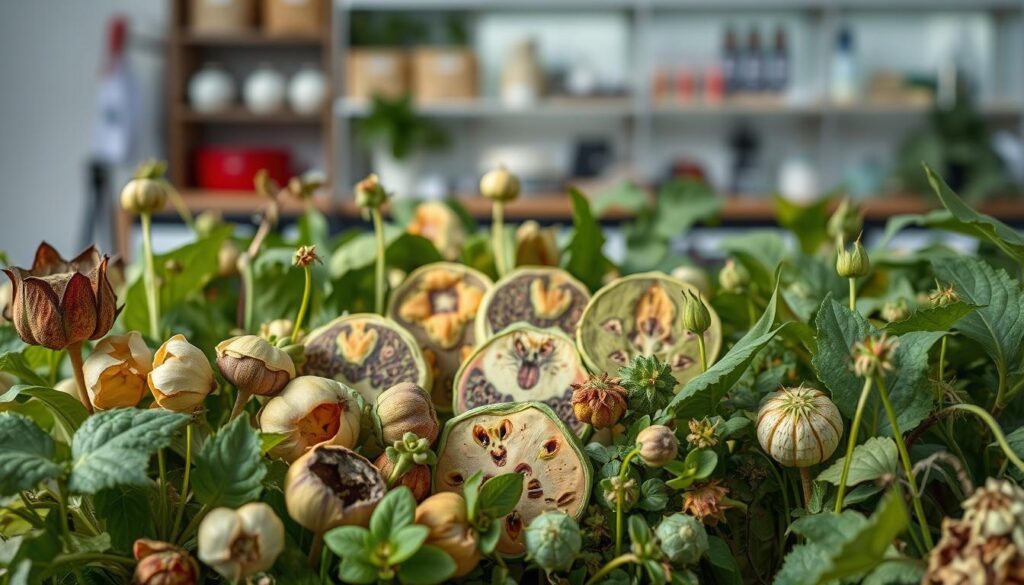Anúncios
Both amateur gardeners and professional farmers face a big problem from plant diseases. These issues can harm the amount and quality of the crops they grow. Understanding the causes of plant diseases is key to creating good ways to fight them. From knowing the many pathogens that cause trouble to seeing how the environment plays a role, this article will give helpful advice on keeping plants healthy. By learning about the different things that can make plants sick, we can better care for our gardens.

Seek App
Overview of Plant Diseases
Plant diseases can be caused by many factors, like tiny living beings and environmental stresses. Things like fungi, bacteria, and viruses lead to many diseases that harm plants. It’s critical to know about these to protect plants and farms.
Anúncios
History has shown us the devastating effects of plant diseases. The American chestnut blight and Dutch elm disease are prime examples. They show how diseases can wipe out whole species of plants. Spotting these diseases early and managing them is key to safe farming and saving plant life.

Anúncios
Causes of Plant Diseases
Knowing why plants get sick is key for great gardening and farming. Many harmful organisms lead to different diseases in plants. Bacteria, fungi, nematodes, and viruses are the big players here.
Pathogens: Bacteria and Fungi
Bacteria cause illnesses like wilt and soft rot. They get in through cuts or tiny openings, growing well when conditions are right. Signs of bacterial diseases include plants wilting or leaves changing color. Fungi, on the other hand, are behind about two-thirds of plant diseases. They attack various parts, causing blights, rots, and molds that can ruin crops.
Nematodes and Viruses
Nematodes are tiny worms that are troublesome in their own way. They munch on plant roots, stopping plants from getting water and nutrients. This can stunt plant growth and cut down on produce. Viruses mess with how plant cells work, causing spotty leaves and smaller plants. They quietly cause a lot of damage, making plant health issues more complicated.
Effects of Environmental Factors
Different factors in the environment greatly affect how healthy plants are. These include the quality of soil and the air around them. Knowing about these factors is key to keeping plants strong and free from diseases.
Abiotic Problems Impacting Plant Health
Abiotic issues cause big problems for those growing plants. Not having enough nutrients can make plants weak. This makes it easy for diseases to attack them. Too much water helps harmful germs grow, and not enough water makes plants less strong.
Air pollution can also harm plants by bringing in dangerous chemicals. These make plants even weaker against diseases. To fight these environmental stresses, it’s important to watch the conditions closely. Using the right way to water plants helps avoid too little or too much water.
Testing soil often can find if nutrients are missing. Then, the soil can be fixed to help plants grow better.
- Monitor soil quality for nutrient deficiencies.
- Implement effective irrigation methods to combat drought.
- Address excessive moisture to prevent pathogen proliferation.
- Manage air quality to mitigate pollution effects.
Types of Plant Diseases
It’s vital to know the types of plant diseases for good prevention and management. Each kind has its own set of challenges. This means we need different ways to control and treat them. Bacterial and fungal diseases are two main types, each harming plants differently.
Bacterial Diseases
Bacterial diseases, like fire blight caused by Erwinia amylovora, greatly affect various plants. This disease thrives in moist conditions, causing plants to quickly die back and infect others fast. Other diseases, such as black rot of crucifers and sweet corn’s bacterial wilt, show why spotting symptoms early is crucial.
Fungal Diseases
Fungal issues affect both food and decorative plants. Examples include downy mildew, anthracnose, and Fusarium wilt. These problems might lead to leaf spots and root rots, making treatment complex. Knowing which fungal disease is attacking your plants is key to fighting it right.
Recognizing Symptoms of Plant Diseases
Spotting signs of plant diseases early is key to keeping gardens and crops healthy. By looking for certain visual cues, we can catch problems quickly. This early detection makes it easier to figure out the disease and treat it fast, helping to prevent bigger issues.
Common Visual Indicators
There are a few visual signs that plants might be sick. Gardeners should watch for these important clues:
- Wilting leaves, which may indicate water stress or root rot.
- Discoloration, such as yellowing leaves, often points to nutrient deficiencies or viral infections.
- Rust spots or lesions that could suggest fungal or bacterial infections.
- Mold growth on leaves or stems, signaling potential decay or moisture issues.
- Necrotic spots that often arise from bacterial or fungal attacks.
By being alert to these signs, gardeners can better diagnose plant diseases. Knowing what to look for means you can take action sooner. This helps keep your plants healthy and strong.
Transmission and Infection Mechanisms
It’s important to know how diseases spread to manage plant diseases well. Diseases move from one host to another in different ways. The environment affects how well they survive and grow. For example, wet conditions help them spread, but they can stop growing if the environment changes.
How Pathogens Spread
Here are the ways diseases can move:
- Water Splashing: Rain or watering can move diseases from sick to healthy plants.
- Insect Vectors: Bugs can carry diseases from one plant to another, making things worse.
- Mechanical Means: Using the same tools on different plants can spread diseases.
Taking steps to prevent diseases is key to keeping plants healthy. Here’s what helps:
- Clean your tools to stop diseases from spreading.
- Water plants in a way that reduces water splashing.
- Watch out for bugs that may carry diseases and deal with them as needed.
Treatment Options for Plant Diseases
To treat plant diseases, we should use a mix of approaches. This includes cultural practices, chemicals, and organic methods. These steps can help plants be healthier and stronger.
Cultural Practices for Prevention
Cultural practices are key to keeping plant diseases away. By using these tactics, we can make it hard for diseases to start. Important steps include:
- Rotate crops annually to disrupt pathogen life cycles.
- Choose resistant plant varieties to reduce susceptibility to diseases.
- Maintain proper garden hygiene by removing plant debris and sanitizing tools.
Chemical Treatments and Organic Solutions
Sometimes, treating plant diseases means using chemicals. Things like sprays that kill bacteria and fungi can help, especially with other preventive steps. However, there are also organic methods that are safe and green. Some good choices are:
- Neem oil, known for its ability to control fungal and insect-related issues.
- Sulfur-based products, which can effectively manage several types of fungal diseases.
Plant Diseases Management Strategies
Keeping crops healthy and ensuring high yields need effective plant disease management. Using clean-up methods and rotating crops help a lot. This approach greatly lowers the chances of diseases in farms.
Sanitation and Crop Rotation
Sanitation is key to cutting down plant diseases. It includes removing sick plant parts to reduce disease sources. Also, cleaning tools and avoiding too much watering help keep diseases away.
Crop rotation is a smart move against diseases. Changing crops each season makes it hard for diseases to last. This not only fights certain diseases but also boosts soil health and nutrients for the next plants.
Conclusion
Knowing about plant diseases is key to keeping gardens healthy. Learning how diseases spread and how to treat them is important. It helps gardeners protect their plants.
Using smart methods like cleaning and choosing disease-resistant plants is crucial. These steps help keep gardens looking good and plants growing well. By following these tips, gardeners can build strong, healthy gardens.
The more gardeners learn, the better they can protect their gardens. Keeping up with new ways to stop plant diseases is helpful. This way, everyone can enjoy beautiful, disease-free gardens.



